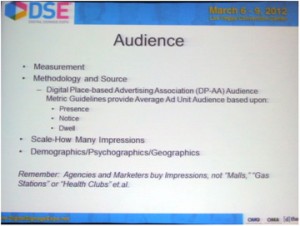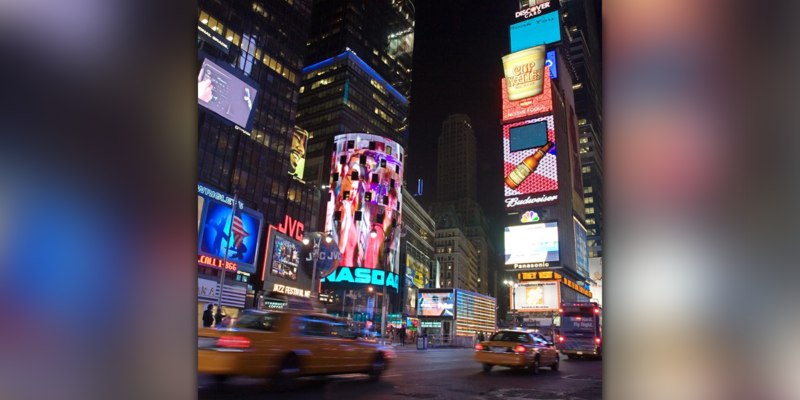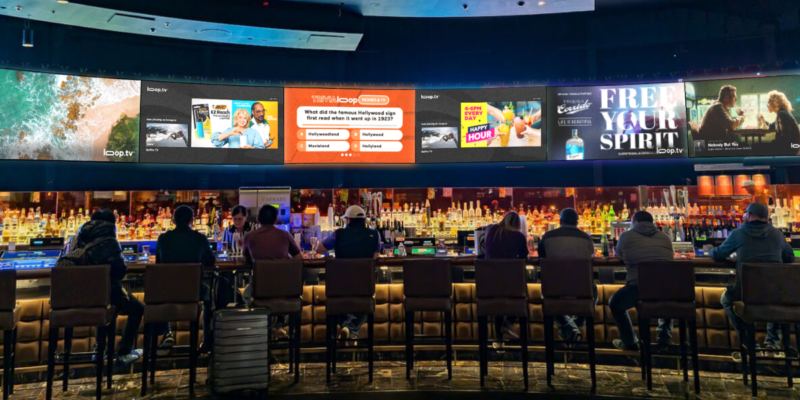Hurdles from the Other Side – Will Advertisers Come to DOOH?
 Does everyone love digital out-of-home signage (DOOH) networks today? Certainly, the display makers see it as a ripe field to plow as excess capacity and maturing consumer markets mean that public displays are getting a lot more attention and push these days. Providers of media players, servers, content creation services, content management systems and other hardware/software providers all love the idea of selling components to network operators. And, cloud operators are happy to provide as much bandwidth as the network can consume.
Does everyone love digital out-of-home signage (DOOH) networks today? Certainly, the display makers see it as a ripe field to plow as excess capacity and maturing consumer markets mean that public displays are getting a lot more attention and push these days. Providers of media players, servers, content creation services, content management systems and other hardware/software providers all love the idea of selling components to network operators. And, cloud operators are happy to provide as much bandwidth as the network can consume.
However, network operators, ad agencies and brands are not as enthusiastic. Guess what — these are the guys who have to pay for all this investment and take all the risk. Does this sound like a little problem to you?
While at Digital Signage Expo last week in Las Vegas, I made an effort to talk to the network operators and ad agencies. What I heard surprised me.
By network operators, I mean the companies that typically own the network of digital signs. This may or may not be advertiser driven. In one panel I sat in, the moderator, Sean Whiffen, founder of AutoNet TV, asked the audience of network operators what their top three concerns were. This turned out to be content, network management and technology, with technology a distant third.
Everyone understands that you should not just reuse content developed for TVs or the web on your network, but feeding the beast is still a big job. Sure, there are many tools out there to access content, format it and schedule it, but it is clearly not enough for these network operators. And, more importantly, advertising agencies want to see quality content on these network as a key element in the decision to recommend advertising on them to their brand customers.
Management of the network was second. Two stories illustrate some concerns. Panelist Matthew Brown, web and interactive manager marketing at Servus Credit Union Ltd., told of having to use five sets of tools to manage a client’s network because it was implemented with five different hardware and software solutions. “That’s like managing five networks, for the price of one,” he said.
A content creator reported that his client asked to test all of the content on the specific player and display in the signage network, and he thought that unreasonable. Panelist Dwayne Brown, senior consultant of digital media and venue technologies at Westbury National Show Systems, responded by saying it was not an unreasonable request as not all mp4 files and players work well together. “You need to test in-house before deployment as the content creator will be blamed if it does not play right.” This led to a discussion of the need for more standards in the industry and a more common language for better communication between the many partners in these solutions.
Another insightful comment from Brown was, “Don’t let the technology drive the decision.” Start with the goals of the network, determine the messages, content and viewing requirements. That will then drive the hardware and software decisions — not the other way around.
A second panel I sat in on consisted of speakers from advertising agencies. They noted that digital signage networks are so diverse and so different, that each one must be individually analyzed to understand the audience, the analytics, and ad effectiveness. This increases the workload for the agencies many fold, compared to other mediums that are much easier to buy for their brand clients. And, it is very hard to put together a national campaign on these networks.
Comments from a network operator in the audience reinforced his frustration in working with these agencies to get the bigger ad accounts, as only a few agencies are investing the time and effort to understand these networks.
Christina Radigan, director of marketing and communication at Outdoor Media Group, noted how they often get network operators coming to them saying they have 1000 convenience stores or 200 gyms on their network and this is our CMP rate. She said, “We don’t buy venues, we buy impressions.” Radigan went on to list the key steps in their evaluation of an ad-based digital signage network: The audience (see photo), the content and the viewing environment.
Lucas Peltonen, DOOH director at OOH Pitch, noted that there was no good way to set a CPM rate for any signage network, so he proposed a 10-step process to determine a rating and a CPM rate. However, he also acknowledged there would be several other factors that could influence the CPM rate. Clearly, this is a hurdle for more widespread use of signage networks by the agencies.
All this tells me there are still many hurdles to growing the digital signage market. Providers of products and services to this industry had better take note. If the more fundamental needs of the network operators, agencies and brands are not addressed, technology push will run into a wall.
 Chris Chinnock is a senior analyst and editor for Insight Media. Reach him at chris@insightmedia.info
Chris Chinnock is a senior analyst and editor for Insight Media. Reach him at chris@insightmedia.info





